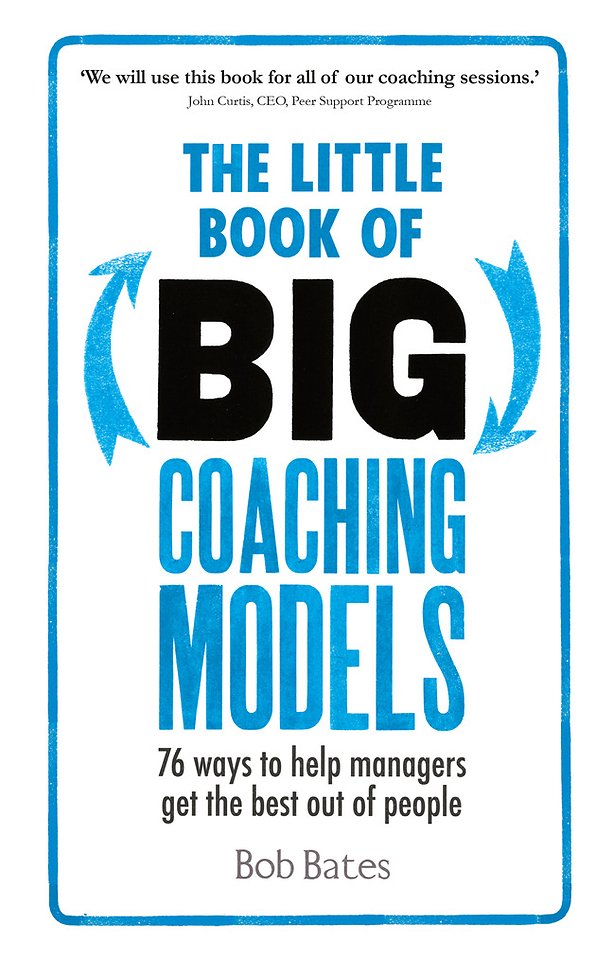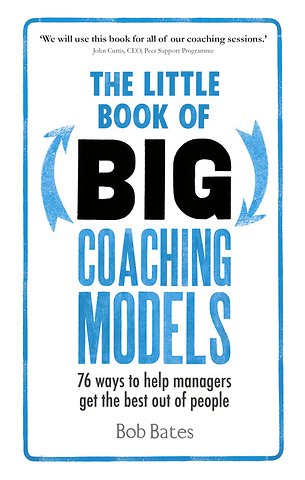Little Book of Big Coaching Models
76 ways to help managers get the best out of people
Paperback Engels 2015 1e druk 9781292081496Samenvatting
De 'Little Book of Big Coaching Models' geeft u toegang tot de beste theorieën en modellen die iedere manager zou moeten kennen en toepassen. Bij ieder model laat de auteur zien wat het is en hoe u het model kunt toepassen zodat u de theorie direct kunt omzetten naar de praktijk.
Specificaties
Lezersrecensies
Inhoudsopgave
PART 1: MAKING A START
Introduction
SECTION 1: UNDERSTAND HOW PEOPLE THINK AND LEARN
Introduction
1. Malcolm Knowles: How adults learn
2. Neil Fleming: VAK
3. David Kolb: Experiential learning cycle
4. Katherine Myers and Isabel Briggs: The Myers-Briggs Type Indicator
SECTION 2: UNDERSTAND WHAT MOTIVATES PEOPLE
Introduction
5. John Keller: The ARCS model of motivational design
6. Douglas McGregor: X and Y theory
7. Frederick Herzberg: Hygiene factors and KITAs
SECTION 3: BE A GOOD COMMUNICATOR
Introduction
8. Michael Argyle: The communication cycle model
9. Eric Berne: Transactional analysis
10. Joseph Luft and Harry Ingram: Johari windows
SECTION 4: SET THE RIGHT OBJECTIVES
Introduction
11. Benjamin Bloom: Levels in the cognitive domain
12. Ravindrakumar Dave: Levels in the psychomotive domain
13. David Krathwol and Benjamin Bloom: Levels in the affective domain
SECTION 5: COACHING THROUGH DIRECTING
Introduction
14. Ivan Pavlov: Classical conditioning
15. Edwin Guthrie: Contiguity theory
16. Robert Merton: Self-fulfilling prophecy
SECTION 6: COACHING THROUGH FACILITATING
Introduction
17. Abraham Maslow: Hierarchy of needs
18. Carl Rogers: Facilitation
19. Jack Mezirow: Transformational learning
SECTION 7: COACHING THROUGH SHOWING OTHERS HOW TO DO IT
Introduction
20. The Gestaltists: Insight theory
21. Karl Pribram, George Miller and Eugene Gallanter: Test-Operate-Test-Exit (TOTE)
22. Albert Bandura: Role modelling
SECTION 8: COACHING THROUGH STIMULATING
Introduction
23. Donald Hebb: Associative learning
24. Leon Festinger: Cognitive dissonance
25. Michael Merzenich: Neuroplasticity
SECTION 9: DEALING WITH CHALLENGING BEHAVIOUR
Introduction
26. Kurt Lewin: Reshaping behaviour
27. Peter Honey: Behaviour modification
28. Robert Hare: Psychopathic checklist
Summary of Part 1
PART 2: TAKING IT FURTHER
Introduction
29. Richard Bandler and John Grinder: Neuro-Linguistic Programming (NLP)
30. Gregory Bateson: Neuro-logical levels
31. Donald Broadbent: Filtering
32. Marty Brounstein: The Five Pillars for Building Commitment
33. Arthur Costa and Bena Kallick: The coach as a critical friend
34. Edward De Bono: The six thinking hats
35. Robert Dilts: The Disney creativity strategy
36. Gerard Egan: The skilled helper model
37. Ferdinand Fournies: Coaching discussion plan
38. Tim Gallwey: The inner game
39. Howard Gardner: Multiple intelligence
40. Andrew Gilbert and Karen Whittleworth: The OSCAR model
41. Daniel Goleman: Emotional intelligence
42. Bruce Grimley: The 7Cs coaching model
43. John Grinder: New Behaviour Generator
44. Richard Hale and Eileen Hutchinson: The INSIGHT coaching cycle
45. Peter Hawkins: The CLEAR model
46. Jon Kabat-Zinn: Mindfulness
47. Max Landsberg: The Tao of coaching
48. David Lane and Sarah Corrie: Purpose, perspectives and process
49. Angus McCleod: The STEPPPA model
50. Alec McPhedran: The GENIUS model
51. Eric Parsloe and Monika Wray: The Seven Golden Rules of Simplicity
52. Jenny Rogers: The Six Principles of Coaching
53. Virginia Satir: Anchoring and self-coaching
54. John Sweller: Cognitive load theory
55. John Whitmore: The GROW model
Summary of Part 2
PART 3 COACHING THE ORGANISATION FOR BETTER PERFORMANCE
Introduction
SECTION 1: COACHING ORGANISATIONAL LEADERS
Introduction
56. John Adair: Action-centred leadership
57. Bernard Bass: Transformational leadership
58. Richard Boyatzis: Self-directed learning
SECTION 2: BE BETTER THAN YOUR COMPETITORS
Introduction
59. Mike Pedlar, John Burgoyne and Tom Boydell: The Learning Company
60. Chris Argyris and Donald Schön: Triple-loop learning
61. Peter Senge: The fifth discipline
SECTION 3: GET THE WORKPLACE CULTURE RIGHT
Introduction
62. Edgar Schein: The three levels of organisational culture
63. Carl Steinhoff and Robert Owens: Cultural metaphors
64. Charles Handy: The culture gods
SECTION 4: BE BETTER AT PLANNING
Introduction
65. Gerry Johnson and Kevan Scholes: Seven stages of strategic planning
66. The McKinsey Group: 7S framework model
67. Mary Bitner and Bernard Booms: The 7Ps marketing mix
SECTION 5: MANAGE QUALITY
Introduction
68. Joseph Juran: The 80–20 rule – the vital few and the trivial many
69. William Edwards-Deming: 14 points for quality management
70. Phil Crosby: The maturity grid
SECTION 6: RESPOND TO CHANGE
Introduction
71. John Kotter: Eight-step approach
72. Elisabeth Kubler-Ross: The grief model
73. John Fisher: The transition curve
SECTION 7: WORK TOGETHER
Introduction
74. Meredith Belbin: Team roles
75. Bruce Tuckman: The team development model
76. Ichak Adizes: Team management personality styles
Summary of Part 3
A final word on coaching
Recommended reading
Index
Anderen die dit boek kochten, kochten ook
Rubrieken
- advisering
- algemeen management
- coaching en trainen
- communicatie en media
- economie
- financieel management
- inkoop en logistiek
- internet en social media
- it-management / ict
- juridisch
- leiderschap
- marketing
- mens en maatschappij
- non-profit
- ondernemen
- organisatiekunde
- personal finance
- personeelsmanagement
- persoonlijke effectiviteit
- projectmanagement
- psychologie
- reclame en verkoop
- strategisch management
- verandermanagement
- werk en loopbaan







